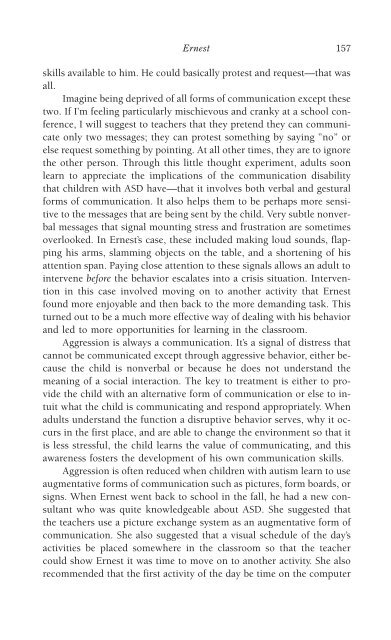978-1572305441
autism
autism
Create successful ePaper yourself
Turn your PDF publications into a flip-book with our unique Google optimized e-Paper software.
Ernest 157<br />
skills available to him. He could basically protest and request—that was<br />
all.<br />
Imagine being deprived of all forms of communication except these<br />
two. If I’m feeling particularly mischievous and cranky at a school conference,<br />
I will suggest to teachers that they pretend they can communicate<br />
only two messages; they can protest something by saying ”no” or<br />
else request something by pointing. At all other times, they are to ignore<br />
the other person. Through this little thought experiment, adults soon<br />
learn to appreciate the implications of the communication disability<br />
that children with ASD have—that it involves both verbal and gestural<br />
forms of communication. It also helps them to be perhaps more sensitive<br />
to the messages that are being sent by the child. Very subtle nonverbal<br />
messages that signal mounting stress and frustration are sometimes<br />
overlooked. In Ernest’s case, these included making loud sounds, flapping<br />
his arms, slamming objects on the table, and a shortening of his<br />
attention span. Paying close attention to these signals allows an adult to<br />
intervene before the behavior escalates into a crisis situation. Intervention<br />
in this case involved moving on to another activity that Ernest<br />
found more enjoyable and then back to the more demanding task. This<br />
turned out to be a much more effective way of dealing with his behavior<br />
and led to more opportunities for learning in the classroom.<br />
Aggression is always a communication. It’s a signal of distress that<br />
cannot be communicated except through aggressive behavior, either because<br />
the child is nonverbal or because he does not understand the<br />
meaning of a social interaction. The key to treatment is either to provide<br />
the child with an alternative form of communication or else to intuit<br />
what the child is communicating and respond appropriately. When<br />
adults understand the function a disruptive behavior serves, why it occurs<br />
in the first place, and are able to change the environment so that it<br />
is less stressful, the child learns the value of communicating, and this<br />
awareness fosters the development of his own communication skills.<br />
Aggression is often reduced when children with autism learn to use<br />
augmentative forms of communication such as pictures, form boards, or<br />
signs. When Ernest went back to school in the fall, he had a new consultant<br />
who was quite knowledgeable about ASD. She suggested that<br />
the teachers use a picture exchange system as an augmentative form of<br />
communication. She also suggested that a visual schedule of the day’s<br />
activities be placed somewhere in the classroom so that the teacher<br />
could show Ernest it was time to move on to another activity. She also<br />
recommended that the first activity of the day be time on the computer



